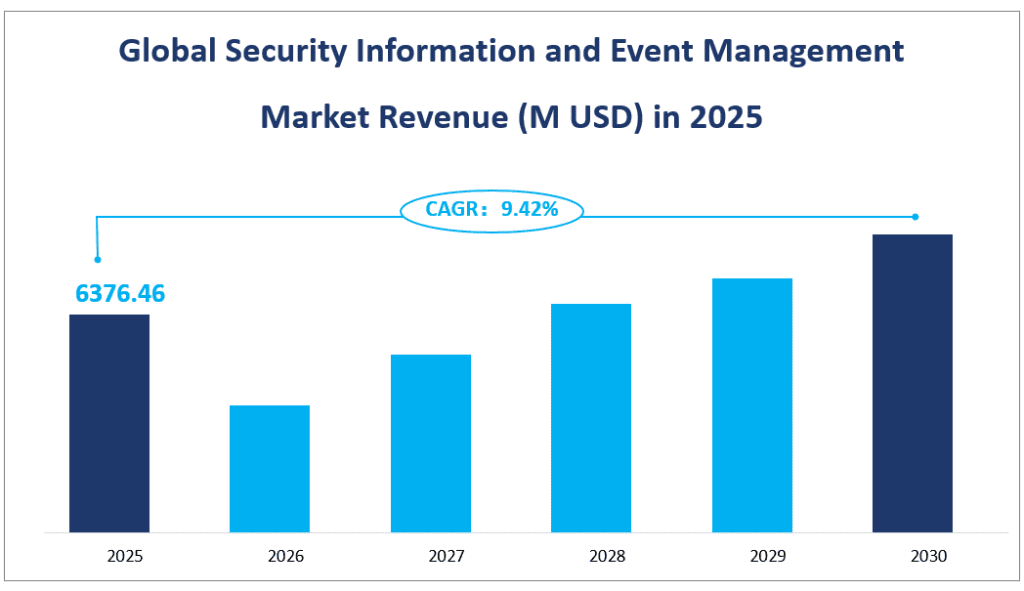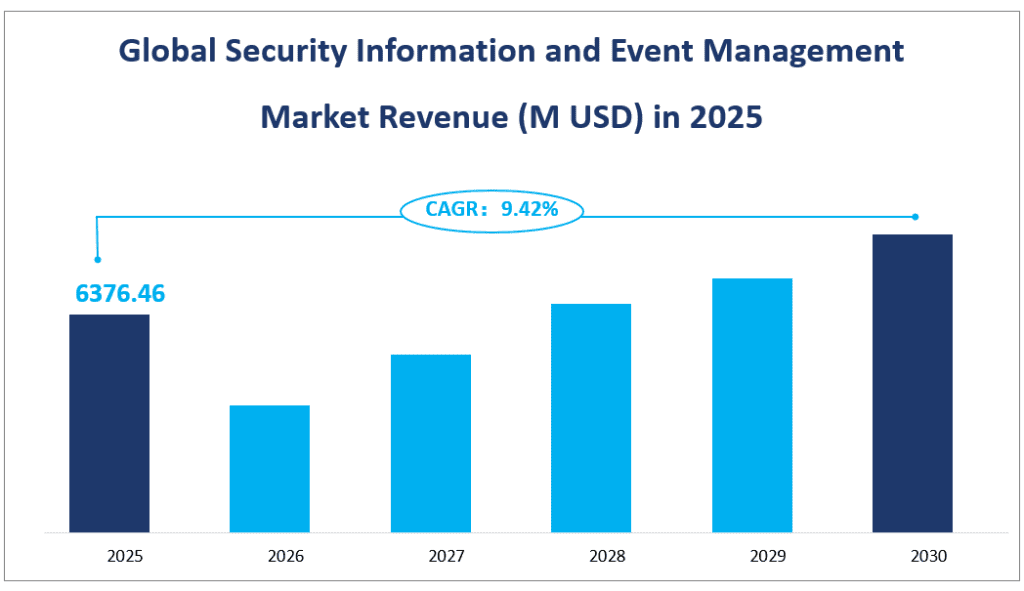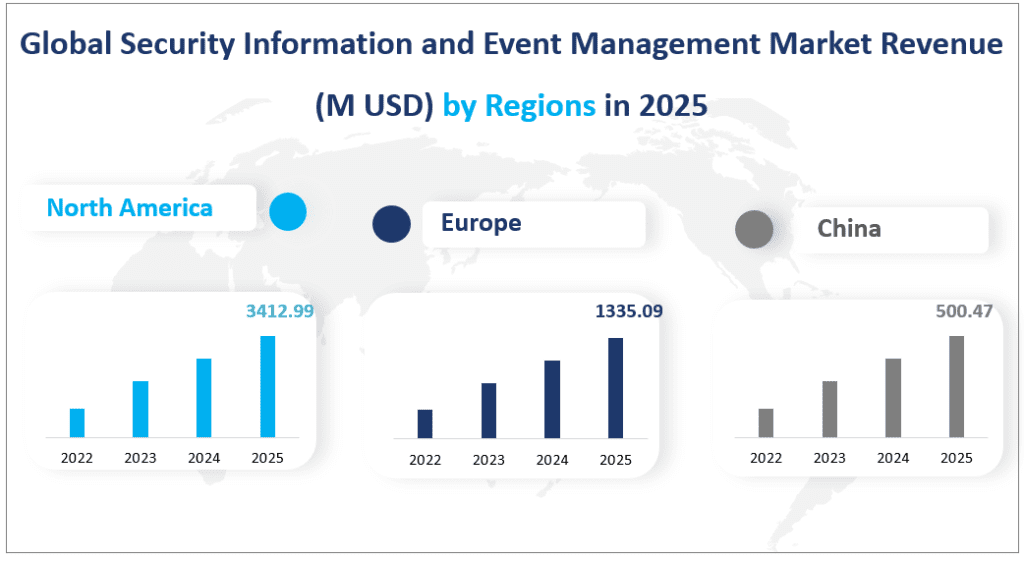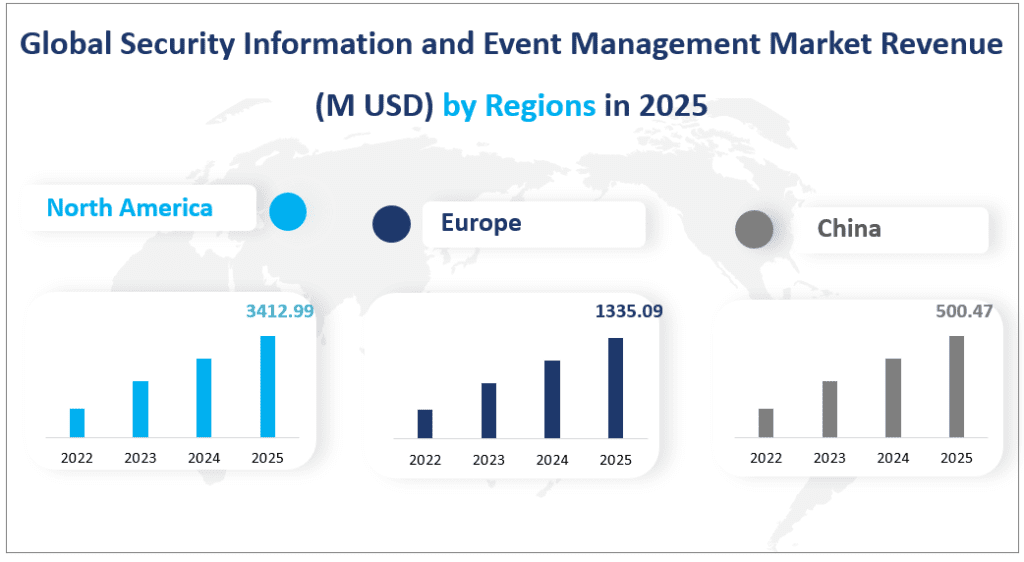1. Global Security Information and Event Management Market
The global Security Information and Event Management market will reach $6376.46 million by 2025 with a CAGR of 9.42% from 2025 to 2030. This indicates a substantial expansion in the market, reflecting the increasing demand for advanced security solutions to manage and analyze security threats in real time.
SIEM, or Security Information and Event Management, is a comprehensive solution combining security information management (SIM) and security event management (SEM). It provides organizations with the ability to monitor, log, and analyze security-related data from various sources across their IT infrastructure. SIEM solutions are designed to detect and respond to security threats, ensuring compliance with regulatory standards and enhancing overall cybersecurity posture. The market’s growth is fueled by the increasing complexity of cyber threats, the need for real-time threat detection, and the growing importance of data privacy and security.
Global Security Information and Event Management Market Revenue (M USD) in 2025


2. Driving Factors of Security Information and Event Management Market
Increasing Concerns Over IT Security: In today’s digital age, IT security has become a critical issue for organizations of all sizes and industries. The rise in cyber threats, data breaches, and sophisticated attacks has led to a heightened demand for comprehensive security solutions. SIEM offers a unified approach to threat detection, log management, and incident response, making it an essential tool for businesses looking to protect their digital assets.
Supportive IT Governance and Regulatory Compliance: Governments and regulatory bodies worldwide are implementing stricter cybersecurity regulations to protect sensitive data and ensure the integrity of digital infrastructure. Compliance with standards such as the Health Insurance Portability and Accountability Act (HIPAA), the Sarbanes-Oxley Act (SOX), and the Payment Card Industry Data Security Standard (PCI DSS) drives the adoption of SIEM solutions. These regulations mandate robust security measures, and SIEM provides the necessary tools to monitor and report on compliance.
Advancements in Technology: The evolution of technology, particularly in the areas of artificial intelligence, machine learning, and big data analytics, has significantly enhanced the capabilities of SIEM solutions. Modern SIEM systems can process vast amounts of data in real time, identify patterns, and detect anomalies that could indicate potential security threats. This advanced functionality enables organizations to respond more effectively to emerging threats and minimize the impact of security incidents.
3. Limiting Factors of Security Information and Event Management Market
Complexity of SIEM Solutions: Implementing and managing SIEM solutions can be complex, requiring specialized skills and expertise. The integration of various security tools, data sources, and third-party threat intelligence adds to the complexity. Organizations often struggle with the ongoing tuning and maintenance required to ensure optimal performance, which can be a barrier to adoption for smaller businesses.
High Costs and Resource Requirements: The initial investment in SIEM solutions can be substantial, including hardware, software, and personnel costs. Additionally, the ongoing maintenance and updates required to keep the system effective can be resource-intensive. This high cost can be prohibitive for some organizations, particularly those with limited budgets or smaller IT teams.
Security and Privacy Concerns: While SIEM solutions are designed to enhance security, they also handle large volumes of sensitive data. Ensuring the security and privacy of this data is paramount, and any lapses can lead to significant consequences. Organizations must ensure that their SIEM solutions are secure and compliant with data protection regulations, which can be a challenging task.
4. Security Information and Event Management Market Segment
Market by Product Types
Log and Event Management is the largest segment within the SIEM market with a value of $2812.66 million in 2025. It involves the collection, storage, and analysis of log data from various sources within an organization’s IT infrastructure. This segment’s growth is driven by the increasing need for real-time monitoring and analysis of security events to detect and respond to potential threats. The ability to manage and analyze large volumes of log data is crucial for organizations to maintain compliance and enhance their security posture.
Firewall Security Management is another significant segment with a size of $1604.32 million in 2025, focusing on the management and optimization of firewall configurations and policies. This segment’s growth is driven by the increasing complexity of network environments and the need for robust firewall solutions to protect against external threats. The integration of advanced analytics and automation in firewall management enhances the effectiveness of security measures, contributing to its growth rate.
Patch Management involves the deployment, distribution, and management of software updates and patches to ensure that systems are secure and up-to-date. This segment’s growth is driven by the need to address vulnerabilities in software and operating systems promptly. Effective patch management is essential for maintaining the security and stability of IT infrastructure, making it a critical component of the SIEM market.
Market Size and Share by Segment
| By Type | Market Size (M USD) in 2025 | Market Share in 2025 |
| Log and Event Management | 2,812.66 | 44.11% |
| Firewall Security Management | 1,604.32 | 25.16% |
| Patch Management | 1,174.54 | 18.42% |
| Others | 784.94 | 12.31% |
Market by Applications
The BFSI sector is the largest application area for SIEM solutions with a market size of $2767.38 million in 205, driven by the high volume of sensitive financial data and the stringent regulatory requirements. Financial institutions require robust security measures to protect against fraud, data breaches, and other cyber threats. The need for real-time monitoring and compliance with regulations such as PCI DSS and SOX drives the adoption of SIEM solutions in this sector.
The healthcare industry is experiencing rapid growth with a market value of $795.14 million in 2025 in the adoption of SIEM solutions, driven by the increasing digitization of patient records and the need to comply with regulations such as HIPAA. Healthcare organizations handle vast amounts of sensitive patient data, making them attractive targets for cybercriminals. The ability to detect and respond to security incidents in real time is crucial for maintaining patient privacy and data integrity.
The telecom and IT sector is another significant application area for SIEM solutions with a market revenue of $527.97 million in 2025. With the increasing complexity of IT infrastructure and the rise in cyber threats, telecom companies and IT service providers require advanced security solutions to protect their networks and data. The need for real-time threat detection and incident response is driving the growth of SIEM in this sector.
The energy and utility sector is a critical infrastructure that requires robust security measures to protect against cyber threats. The increasing reliance on digital technologies and the potential impact of cyber attacks on energy supply make SIEM solutions essential for monitoring and protecting critical assets.
The retail and hospitality industry handles large volumes of customer data, making it a target for cybercriminals. The need to protect customer information and comply with regulations such as PCI DSS drives the adoption of SIEM solutions in this sector.
Educational institutions are increasingly adopting SIEM solutions to protect student and faculty data, research information, and intellectual property. The need to comply with data protection regulations and ensure the security of digital assets drives the growth of SIEM in the education sector.
Market Size and Share by Segment
| By Application | Market Size (M USD) in 2025 | Market Share in 2025 |
| Banking, Financial Services and Insurance (BFSI) | 2,767.38 | 43.40% |
| Government | 381.31 | 5.98% |
| Healthcare | 795.14 | 12.47% |
| Telecom and Information Technology (IT) | 527.97 | 8.28% |
| Energy and Utility | 243.58 | 3.82% |
| Retail and Hospitality | 650.40 | 10.20% |
| Education and Academia | 271.00 | 4.25% |
| Others | 739.67 | 11.60% |
5. Regional Security Information and Event Management Market
North America has historically been the largest market for SIEM solutions with a market size of $3412.99 million in 2025, driven by the presence of major technology companies and a high demand for advanced cybersecurity solutions. The region’s robust IT infrastructure and stringent regulatory environment, such as the Health Insurance Portability and Accountability Act (HIPAA) and the Sarbanes-Oxley Act (SOX), have led to significant adoption of SIEM technologies. The continuous innovation and investment in cybersecurity by major players in the region further solidify its position as the largest market.
Europe is the second-largest market for SIEM solutions with a market size of $1335.09 million in 2025, driven by the need for compliance with strict data protection regulations such as the General Data Protection Regulation (GDPR). The region’s focus on data privacy and security has led to significant investments in SIEM technologies. The presence of major financial institutions and healthcare providers in Europe also contributes to the demand for advanced security solutions.
China is one of the fastest-growing markets for SIEM solutions with a market size of $500.47 million in 2025, driven by rapid digital transformation and increasing awareness of cybersecurity threats. The Chinese government’s focus on cybersecurity and data protection has led to significant investments in the sector. The growth of the BFSI industry and the increasing adoption of cloud-based solutions further drive the demand for SIEM technologies in China.
North America remains the largest regional market for SIEM solutions. The region’s robust IT infrastructure and stringent regulatory environment drive the significant adoption of SIEM technologies. However, China is the fastest-growing regional market, reflecting the rapid digital transformation and increasing awareness of cybersecurity threats in the country.
Global Security Information and Event Management Market Revenue (M USD) by Regions


6. Top 3 Companies in the SIEM Market
IBM Qradar
Company Introduction and Business Overview: IBM Qradar is a leading provider of SIEM solutions, offering advanced security analytics and threat detection capabilities. The company’s solutions are designed to help organizations manage and analyze security-related data from various sources, providing real-time insights and actionable intelligence.
Products Offered: IBM Qradar offers a comprehensive suite of SIEM products, including Log and Event Management, Firewall Security Management, and advanced threat detection solutions. The company’s products are known for their scalability, flexibility, and integration capabilities.
Micro Focus
Company Introduction and Business Overview: Micro Focus is a global software company that offers a wide range of enterprise software solutions, including SIEM. The company’s SIEM solutions are designed to help organizations manage and analyze security-related data, providing real-time threat detection and response capabilities.
Products Offered: Micro Focus offers a comprehensive suite of SIEM products, including Log and Event Management, Patch Management, and advanced threat detection solutions. The company’s products are known for their robustness, scalability, and ease of use.
Splunk
Company Introduction and Business Overview: Splunk is a leading provider of data analytics solutions, including SIEM. The company’s solutions are designed to help organizations manage and analyze large volumes of data, providing real-time insights and actionable intelligence. Splunk’s SIEM solutions are particularly known for their advanced analytics capabilities.
Products Offered: Splunk offers a comprehensive suite of SIEM products, including Log and Event Management, advanced threat detection, and user behavior analytics. The company’s products are known for their flexibility, scalability, and integration capabilities.
1 Report Overview
1.1 Study Scope
1.2 Key Market Segments
1.3 Players Covered: Ranking by Security Information and Event Management Revenue
1.4 Market by Type
1.4.1 Global Security Information and Event Management Market Size Growth Rate by Type: 2020 VS 2026
1.4.2 Log and Event Management Market Value (M USD) and Growth Rate (2015-2020)
1.4.3 Firewall Security Management Market Value (M USD) and Growth Rate (2015-2020)
1.4.4 Patch Management Market Value (M USD) and Growth Rate (2015-2020)
1.5 Market by Application
1.5.1 Global Security Information and Event Management Market Share by Application: 2020 VS 2026
1.5.2 Banking, Financial Services and Insurance (BFSI) Market Value (M USD) and Growth Rate (2015-2020)
1.5.3 Government Market Value (M USD) and Growth Rate (2015-2020)
1.5.4 Healthcare Market Value (M USD) and Growth Rate (2015-2020)
1.5.5 Telecom and Information Technology (IT) Market Value (M USD) and Growth Rate (2015-2020)
1.5.6 Energy and Utility Market Value (M USD) and Growth Rate (2015-2020)
1.5.7 Retail and Hospitality Market Value (M USD) and Growth Rate (2015-2020)
1.5.8 Education and Academia Market Value (M USD) and Growth Rate (2015-2020)
1.6 Study Objectives
1.7 Years Considered
2 Global Growth Trends
2.1 Global Security Information and Event Management Market Perspective (2015-2026)
2.2 Global Security Information and Event Management Growth Trends by Regions
2.2.1 Security Information and Event Management Market Size by Regions: 2015 VS 2020 VS 2026
2.2.2 Security Information and Event Management Market Share by Regions (2015-2020)
2.2.3 Security Information and Event Management Forecasted Market Size by Regions (2021-2026)
2.3 Industry Trends and Growth Strategy
2.3.1 Market Trends
2.3.2 Market Drivers
2.3.3 Market Challenges
2.3.4 Porter’s Five Forces Analysis
2.3.5 Security Information and Event Management Market Growth Strategy
2.4 Security Information and Event Management Industry Development Trends under COVID-19 Outbreak
2.4.1 Global COVID-19 Status Overview
2.4.2 Influence of COVID-19 Outbreak on Security Information and Event Management Industry Development
3 Competition Landscape by Key Players
3.1 Global Top Security Information and Event Management Players by Market Size
3.1.1 Global Top Security Information and Event Management Players by Revenue (2015-2020)
3.1.2 Global Security Information and Event Management Revenue Market Share by Manufacturers (2015-2020)
3.1.3 Global Security Information and Event Management Market Share by Company Type (Tier 1, Tier 2 and Tier 3)
3.2 Global Security Information and Event Management Market Concentration Ratio
3.2.1 Global Security Information and Event Management Market Concentration Ratio (CR5)
3.2.2 Global Top 10 and Top 5 Companies by Security Information and Event Management Revenue Share in 2019
3.3 Security Information and Event Management Key Players Head office and Area Served
3.4 Date of Enter into Security Information and Event Management Market
3.5 Mergers & Acquisitions, Expansion Plans
4 Market Size by Type (2015-2026)
4.1 Global Security Information and Event Management Market Size by Type (2015-2020)
4.2 Global Security Information and Event Management Forecasted Market Size by Type (2021-2026)
5 Market Size by Application (2015-2026)
5.1 Global Security Information and Event Management Market Size by Application (2015-2020)
5.2 Global Security Information and Event Management Forecasted Market Size by Application (2021-2026)
6 North America
6.1 North America Security Information and Event Management Market Size (2015-2020)
6.2 Security Information and Event Management Key Players in North America 2019
6.3 North America Security Information and Event Management Market Size by Type (2015-2020)
6.4 North America Security Information and Event Management Market Size by Application
7 Europe
7.1 Europe Security Information and Event Management Market Size (2015-2020)
7.2 Security Information and Event Management Key Players in Europe
7.3 Europe Security Information and Event Management Market Size by Type (2015-2020)
7.4 Europe Security Information and Event Management Market Size by Application (2015-2020)
8 China
8.1 China Security Information and Event Management Market Size (2015-2020)
8.2 China Security Information and Event Management Market Size by Type (2015-2020)
8.3 China Security Information and Event Management Market Size by Application
9 Japan
9.1 Japan Security Information and Event Management Market Size (2015-2020)
9.2 Japan Security Information and Event Management Market Size by Type (2015-2020)
9.3 Japan Security Information and Event Management Market Size by Application (2015-2020)
10 Southeast Asia
10.1 Southeast Asia Security Information and Event Management Market Size (2015-2020)
10.2 Southeast Asia Security Information and Event Management Market Size by Type (2015-2020)
10.3 Southeast Asia Security Information and Event Management Market Size by Application (2015-2020)
11 India
11.1 India Security Information and Event Management Market Size (2015-2020)
11.2 India Security Information and Event Management Market Size by Type (2015-2020)
11.3 India Security Information and Event Management Market Size by Application (2015-2020)
12 Central & South America
12.1 Central & South America Security Information and Event Management Market Size (2015-2020)
12.2 Central & South America Security Information and Event Management Market Size by Type (2015-2020)
12.3 Central & South America Security Information and Event Management Market Size by Application (2015-2020)
13 Analyst’s Viewpoints/Conclusions
14 Appendix
14.1 Research Methodology
14.1.1 Methodology/Research Approach
14.1.2 Data Source
14.2 Disclaimer
